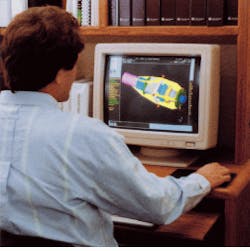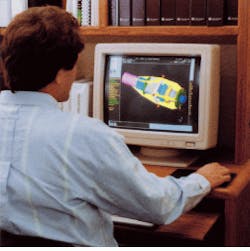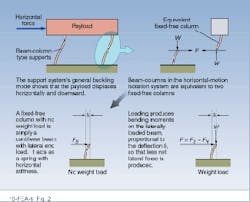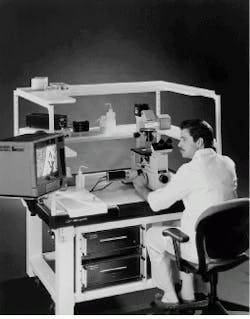How to identify suitable vibration-control solutions
How to identify suitable vibration-control solutions
Modal analysis testing can pinpoint the causes of vibration and help to decide whether passive or active solutions will solve your problems.
Bowie Houghton
Deciding what to do is no small task if you suspect that vibration is undermining a sensitive laboratory project or manufacturing procedure. For tasks such as reducing vibration of sensitive equipment, lowering noise, quieting optical system jitter, or preventing metal fatigue, determining the nature of problem is the first critical step in assessing vibration-control methods available to you. Without training, experience, and equipment to analyze a set-up, you may be just guessing--which can consume time and money, especially if the problem is not vibration at all.
Several manufacturers offer free vibration analysis, so any vibration problem can be characterized before investing in a solution. Many consultants also offer state-of-the-art tools and expertise to analyze vibration problems (see Fig. 1). Knowledge of how vibration creates relative motion and of how modal-analysis testing can assess where to place critical research or production equipment will also help you determine the best solution to your vibration-control problems.
Understanding relative motion
To illustrate how vibration can be a limiting factor, consider the task of photographing a highly magnified image through a microscope. The microscope, coupled with camera optics, determines where the image of each object point resides on the film plane. If every point of the optical system is synchronized during the exposure time with no relative motion, the image is clear. Relative motion of the sample with respect to the objective lens causes a blurry image. Relative motion control is also critical in optical interferometry, holography, and similar disciplines, because the allowable displacement tolerances are much smaller.
It is impossible to create a perfectly rigid structure or to completely eliminate the sources of noise. Keeping that in mind, the goal of a perfectly rigid structure is approached by reducing the relative motion between different elements by connecting them with as rigid a link as possible. In a theoretically perfect rigid body, the distance between any two points is constant--all the elements mounted together will not move relative to each other, and system performance will not be impaired.
Modal analysis takes the concept of relative motion one step further by providing a three-dimensional graphic representation of, for example, displacements of an entire work surface, such as an optical table top. In addition to providing direct, experimental proof of vibration isolation and structural performance, modal analysis identifies the "sweet spots" on the structure, that is, the spots where the motion of the work surface is lowest. Pinpointing these locations indicates the best placement for critical equipment to achieve the highest stability and performance.
Modal-analysis testing characterizes the deformation of a structure due to vibration input. When the structure is excited by vibrational energy, it is deformed in a number of well-defined wave-like patterns or modes. Each mode has its own specific natural frequency and mode shape. Five factors are critical to building a vibration control system: connecting all of the critical elements together in as dynamically rigid a structure as possible to minimize structural resonances; isolating the system from as much external vibration as possible; building a statically rigid structure that deforms as little as possible with external force application, such as heavy load; minimizing temperature variation in the environment; and designing the structure to be as insensitive to temperature as possible.
Passive solutions
There are a number of passive vibration-control solutions. These methods are ideally suited for research and development applications that do not require expensive, higher-precision electronic systems to control vibrations. One solution is to use optical breadboards with dampers that can deliver high resolution and performance. Breadboards provide a particularly effective way to expand the useful area of an optical table or provide additional stable optical surfaces. They can be mounted from beneath the table or elevated above it on posts. Examples of such breadboards include the Newport Carbon E carbon-epoxy models that offer high stiffness, low weight, and low thermal expansion, also Formel granite-honeycomb structures having granite`s flatness combined with the light weight and damping of the honeycomb core.
Breadboards are not intended as a substitute for optical tables because their size-to-thickness ratio produces relatively low end-to-end rigidity. However, breadboard local rigidity over distances of less than about 1-2 ft is excellent. When a breadboard is attached solidly to a dynamically rigid optical table, the performance of its working surface becomes comparable to that of the table itself. Sealed holes and steel cores are now standard in the majority of breadboards.
Mechanical isolation systems incorporating negative-stiffness mechanisms are another passive isolation method well suited for ultraprecision systems needing vibration control beyond the capabilities of conventional pneumatic isolator technology. Negative-stiffness mechanisms are suitable where changes in weight are small or can be compensated for manually (see Fig. 2). Applications include isolating analytical balances, microscopes, metrology and microelectronics equipment, precision machine tools, patch clamping stations, and medical and industrial laser and optical systems.
With the development of atomic force microscopes and scanning tunneling microscopes that probe with sub-angstrom resolution, even the most minute low-frequency vibrations have disastrous effects on performance. Where vibrations are significant, such as on the upper floors of buildings, negative-stiffness mechanisms can reduce low-frequency induced vibrational noise by a minimum factor of three to five. Low-frequency vibration isolation improves resolution of instruments, increases yield of fabrication equipment, and eliminates the need to curtail vibration-inducing activities.
One of the most important indicators of table rigidity is its stiffness-to-weight ratio. A higher ratio increases the resonant frequency of the table top, resulting in a lower dynamic deflection coefficient and less table motion. Lower table weight is the major reason why honeycomb core tables outperform the granite slabs popular in the past. The highest-performing tables are the stiffest and lightest, weighing about 35% less than ordinary tables and offering more than twice the torsional rigidity.
Damping for isolation
Vibration isolation workstations, such as the Newport IsoStation, assist researchers and manufacturers in obtaining sharper image quality, faster throughput, more accurate measurements, and improved positioning stability in life-science applications, semiconductor fabrication, and precision assembly (see Fig. 3). These workstations minimize relative motion by connecting all elements to an ultrastable table-top structure and isolating the top from ground vibrations. Honeycomb top construction provides low weight with high stiffness, permitting high dynamic rigidity and minimal relative motion between components.
Patented pneumatic-isolation technology protects the table top from floor vibrations in both the vertical and horizontal planes. The hybrid-chamber design enhances the link between piston motion and damper air flow, producing greater damping force for faster and more efficient damping and reduced settling time.
Active electronic vibration control
As integrated-circuit photolithographic line widths become narrower, higher-precision vibration-control systems are required to enable semiconductor manufacturers to meet stringent throughput and yield goals. Digital signal-processing controllers, as well as faster and smarter computer chips, are advancing electronic cancellation of vibrations. Currently, such vibration-isolation systems designed for use in semiconductor fabrication facilities enable manufacturers to achieve higher chip density and yield by stabilizing precision machinery, even for large excitation forces.
These systems allow steppers, mask-inspection machines, and laser trimmers to operate at maximum speeds without excessive vibration or motion in almost any environment. Semiconductor manufacturers then have flexibility in where they locate their machines, especially in existing or refurbished installations where noise and vibration can be reduced only by expensive construction of specialized foundations and pilings.
One active system, the STACIS 2000, provides a high-precision electronic solution to vibration problems for both research and manufacturing environments. With active vibration control of up to 250 Hz, the system combines piezoceramic actuators in series with an elastomer, offering vibration isolation over a wide frequency range.
Acoustic enclosures
Acoustic attenuation is a requirement in systems such as high-resolution metrology equipment. Surface profilometers, for example, have such high resolution that a human voice can affect measurements. Acoustic enclosures provide a passive solution in such instances. These devices are fabricated from attenuating foams built into a protective enclosure. These enclosures will also feature active noise cancellation in the near future.
Semiconductor manufacturing equipment is not the only area in which requirements for improved accuracy are becoming critical. In the machine-tool industry, increased worldwide competition combined with ever more stringent tolerance and surface-finish requirements are necessitating improved vibration control in precision-machining operations. Vibration reduction enables higher part yields and extends tool life. As new problems and issues arise, vibration-control consultants, professional testing services, and in-house experts will become more common. o
FIGURE 1. Software programs can perform vibrational analysis to characterize potential problems before a user invests in a solution.
FIGURE 2. Negative-stiffness mechanisms utilize nonlinear characteristics of beam columns to achieve very low spring constants and sub-hertz vibration isolation.
FIGURE 3. Specialized vibration-isolation workstations minimize relative motion by having all elements connected to a rigid, stable structure as well as isolating the table to¥from ground vibrations.



